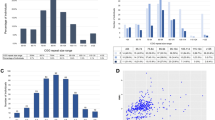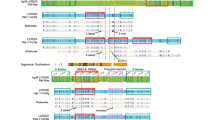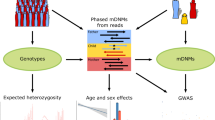Abstract
While studying founder chromosomes in the fragile X syndrome, we have unexpectedly found linkage equilibrium to FRAXAC2, an Alu–associated microsatellite within the defective gene, FMR–1. DNA sequencing of 265 chromosomes revealed 39 alleles and a complex microsatellite of form (GT)x–C–(TA)y–(T)z. A mutation rate of 3.3% was observed but only among fragile X maternally derived meioses. Finding a second mutable locus within FMR–1 suggests that the target for tandem repeat instability may not be confined to the (CGG)nrepeat alone and raises the possibility of an FMR–1 mutation mechanism involving microsatellites.
This is a preview of subscription content, access via your institution
Access options
Subscribe to this journal
Receive 12 print issues and online access
$209.00 per year
only $17.42 per issue
Buy this article
- Purchase on Springer Link
- Instant access to full article PDF
Prices may be subject to local taxes which are calculated during checkout
Similar content being viewed by others
References
Brown, W.T. & Jenkins, E.C. The Fragile X Syndrome. In Molecular Genetic Medicine, Vol II. (ed. Friedmann, T.) 39–66 (Academic, San Diego, 1992).
Fu, Y.H. et al. Variation of the CGG repeat at the fragile x site results in genetic instabilitiy: resolution of the Sherman paradox. Cell 67, 1047–1058 (1991).
Verkerk, A.J.M.H. et al. Identification of a Gene (FMR-1) Containing a CGG Repeat Coincident with a Breakpoint Cluster Region Exhibiting Length Variation in Fragile X Syndrome. Cell 65, 905–914 (1991).
Pieretti, M. et al. Absence of Expression of the FMR-1 Gene in Fragile X Syndrome. Cell 66, 1–20 (1991).
Brown, W.T. et al. Rapid fragile X carrier screening and prenatal diagnosis using a PCR test. JAMA 270, 1569–1575 (1993).
Brook, J.D. et al. Molecular basis of myotonic dystrophy: expansion of a trinucleotide (CTG) repeat at the 3′ end of a transcript encoding a protein kinase family member. Cell 68, 799–808 (1992).
La Spada, A.R., Wilson, E.M., Lubahn, D.B., Harding, A.E. & Fischbeck, K.H. Androgen receptor gene mutations in X-linked spinal and bulbar muscular atrophy. Nature 352, 77–79 (1991).
Huntington's Collaborative Disease Network. A novel gene containing a trinucleotide repeat that is expanded and unstable on Huntington's Disease chromosomes. Cell 72, 971–983 (1993).
Orr, H.T. et al. Expansion of an Unstable Trinucleotide CAG Repeat in Spinocerebellar Ataxia Type-1. Nature Genet. 4, 221–226 (1993).
Knight, S.J.L. et al. Trinucleotide repeat amplification and hypermethylation of a CpG island in FRAXE mental retardation. Cell 74, 127–134 (1993).
Harley, H.G. et al. Detection of linkage disequilibrium between the myotonic dystrophy locus and a new polymorphic DNA marker. Am. J. hum. Genet. 49, 68–75 (1991).
Richards, R.I. et al. Evidence of founder chromosomes in fragile X syndrome. Nature Genet. 1, 257–260 (1992).
Richards, R.I. et al. Fragile X syndrome: Genetic localisation by linkage mapping of two microsatellite repeats FRAXAC1 and FRAXAC2 which immediately flank the fragile site. J. med. Genet. 28, 818–823 (1991).
Oudet, C. et al. Linkage disequilibrium between the fragile X mutation and two closely linked CA repeats suggests that fragile X chromosomes are derived from a small number of founder chromosomes. Am. J. hum. Genet. 52, 297–304 (1993).
Smits, A.P.T. et al. The fragile X syndrome: No evidence for any recent mutations. J. med. Genet. 30, 94–96 (1993).
Imbert, G., Kretz, C., Johnson, K. & Mandel, J.-L. Origin of the expansion mutation in myotonic dystrophy. Nature Genet. 4, 72–76 (1993).
Levinson, G. & Gutman, G.A. Slipped-strand mispairing: A major mechanism of DNA sequence evolution. Molec. Biol. Evol. 4, 203–221 (1987).
Schlotterer, C. & Tautz, D. Slippage synthesis of simple sequence DNA. Nucl. Acids Res. 20, 211–215 (1992).
Jurka, J. & Smith, T. A fundamental division in the Alu family of repeated sequences. Proc. natn Acad. Sci. U.S.A. 85, 4775–4778 (1988).
Zuliani, G. & Hobbs, H.H. A high frequency of length polymorphisms in repeated sequences adjacent to Alu sequences. Am. J. hum. Genet. 46, 963–969 (1990).
Economou, E.P., Bergen, A.W., Warren, A.C. & Antonarakis, S.E. The polydeoxyadenylate tract of Alu repetitive elements is polymorphic in the human genome. Proc. natn Acad. Sci. U.S.A. 87, 2951–2954 (1990).
Beckmann, J.S. & Weber, J.L. Survey of Human and Rat Microsatellites. Genomics 12, 627–631 (1992).
Petersen, M.B. et al. Use of short sequence repeat DNA polymorphisms after PCR amplification to detect the parental origin of the additional chromosome 21 in Down syndrome. Am. J. hum. Genet. 48, 65–71 (1991).
Chu, C., Trapnell, B.C., Curristin, S., Cutting, G.R. & Crystal, R.G. Genetic basis of variable exon 9 skipping in cystic fibrosis transmembrane conductance regulator mRNA. Nature Genet. 3, 151–156 (1993).
Shriver, M.D., Seist, G. & Boerwinkle, E. Length and sequence variation in the apolipoprotein B intron 20 Alu repeat. Genomics 14, 449–454 (1992).
Weissenbach, J. et al. A second-generation linkage map of the human genome. Nature 359, 794–801 (1992).
Jeffreys, A.J., Royle, N.J., Wilson, V. & Wong, Z. Spontaneous mutation rates to new length alleles at tandem-repetitive hypervariable loci in human DNA. Nature 332, 278–281 (1988).
Vergnaud, G., Mariat, D., Apiou, F., Aurians, A., Lathrop, M. & Lauthier, V. The use of synthetic tandem repeats to isolate new VNTR loci: cloning of a human hypermutable sequence. Genomics 11, 135–144 (1991).
Morral, N., Numes, V., Casals, T. & Estivill, X. CA/GT microsatellite alleles within the cystic fibrosis transmembrane conductance regulator (CFTR) gene are not generated by unequal crossing over. Genomics 10, 692–698 (1991).
Gibbs, M., Collick, A., Kelly, R.G. & Jeffreys, A.J. A tetranucleotide repeat mouse minisatellite displaying substantial somatic instability during early preimplantation development. Genomics 17, 121–128 (1993).
Aaltonen, L.A. et al. Clues to the pathogenesis of familial colorectal cancer. Science 262, 812–816 (1993).
Author information
Authors and Affiliations
Rights and permissions
About this article
Cite this article
Zhong, N., Dobkin, C. & Brown, W. A complex mutable polymorphism located within the fragile X gene. Nat Genet 5, 248–253 (1993). https://doi.org/10.1038/ng1193-248
Received:
Accepted:
Issue Date:
DOI: https://doi.org/10.1038/ng1193-248
This article is cited by
-
The FMR1 CGG repeat and linked microsatellite markers in two Basque valleys
Heredity (2003)
-
FMR1 haplotype analyses among Indians: a weak founder effect and other findings
Human Genetics (2003)
-
Positioned to expand
Nature Genetics (2002)
-
Minisatellite mutation rate variation associated with a flanking DNA sequence polymorphism
Nature Genetics (1994)
-
FRAXAC2 instability
Nature Genetics (1994)



